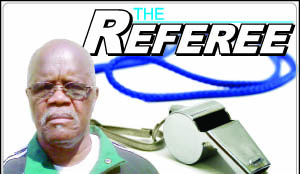 Preamble:
Preamble:
IN Law 12 Fouls and Misconduct Part 1 edition of this column which was carried a few weeks ago, I outlined 10 fouls which attract a Direct
Free-Kick.
I also stated that a Penalty-Kick was awarded to the opposing team if any of the 10 Direct Free-Kick offences was committed by a player inside his own Penalty-Area, irrespective of the position of the ball, provided however, that the ball is in play.
Most of the soccer lovers do not seem to know that Kicks taken from the Penalty-Mark at the end of some drawn Competition Games are not part of the Penalty-Kick taken during the normal course of play, or time has been extended at half-time or full-time to allow a Penalty-Kick to be taken or retaken.
In this light, today’s episode is based on Law 14 The Penalty-Kick and next week I will deal in fine details the application of the
Kick-Kicks from the Penalty-Mark.
Penalty-Kick:
A penalty-kick is awarded against a team that commits one of the 10 offences for which a direct free-kick is awarded, inside its own penalty-area and while the ball is in play.
A goal may be scored directly from a penalty-kick. Additional time is allowed for a penalty-kick to be taken at the end of each half or at the end of periods of extra-time.
Position of the ball and players:
The Ball:
* The ball must be placed on the penalty-mark. The player taking the penalty-kick
* Must be properly identified The defending goal-keeper:
* Must remain on his goal-line, facing the kicker, between the goal-posts until the ball has been kicked.
The players other than the kicker must be located:
* Inside the field of play.
* Outside the penalty-area.
* Behind the penalty-mark.
* At least 9.15 metres from the penalty-mark.
Procedure:
* After the players have taken positions in accordance with this Law, the referee signals for the penalty-kick to be taken.
* The player taking the penalty-kick must kick the ball forward.
* He must not play the ball again until it has touched another player.
* The ball is in play when it is kicked and moves forward.
Feinting in the run-up to take a penalty-kick to confuse opponents is permitted as part of football. However, feinting to kick the ball once
the player has completed his run-up is considered an infringement of Law 14 and an act of unsporting behaviour for which a player must be
cautioned.
When a penalty-kick is taken during the normal course of play, or time has been extended at half-time or full-time to allow a penalty-kick to be taken or retaken, a goal is awarded if, before passing between the goal-posts and under the cross-bar:
* The ball touches either or both of the goal-posts and/or the cross-bar and/or the goal-keeper.
The referee decides when a penalty-kick has been completed. Infringements and Sanctions:
If the referee gives the signal for a penalty-kick to be taken and, before the ball is in play, one of the following occurs:
The player taking the penalty-kick infringes the Laws of the Game:-
* The referee allows the penalty-kick to taken.
* If the ball enters the goal, the penalty-kick is retaken.
* If the ball does not enter the goal, the referee stops play and the match is restarted with an indirect free-kick to the defending team from the place where the infringement occurred.
The goal-keeper infringes the Laws of the Game:-
* The referee allows the penalty-kick to be taken
* If the ball enters the goal, a goal is awarded
* If the ball does not enter the goal, the kick is retaken A team-mate of the player taking the penalty-kick infringes the Laws of the Game:-
* The referee allows the penalty-kick to be taken
* If the ball enters the goal, the penalty-kick is retaken
* If the ball does not enter the goal, the referee stops play and the match is restarted with an indirect free-kick to the defending team from the place where the infringement occurred.
A team-mate of the goal-keeper infringes the Laws of the Game:-
* The referee allows the penalty-kick to be taken
* If the ball enters the goal, a goal is awarded
* If the ball does not enter the goal, the penalty-kick is retaken
A player of both the defending team and the attacking team infringe the Laws of the Game:-
* The penalty-kick is retaken If, the referee gives the signal and, after the penalty-kick has been taken:
The kicker touches the ball again (except with hands) before it has touched another player:
* An indirect free-kick is awarded to the opposing team, to be taken from the place where infringement occurred, unless the infringement
occurred inside the goal-area in which case the kick is taken from an point in that area.
The kicker deliberately handles the ball before it has touched another player:
* A direct free-kick is awarded to the opposing team, to be taken from the place where the infringement occurred, unless the infringement
occurred inside the goal-area in which case the kick is taken from any point inside that area.
The ball is touched by an outside agent as it goes forward:-
* The penalty-kick is retaken.
The ball rebounds into the field of play from the goal-keeper, the cross-bar or the goal-posts and is the touched by an outside agent:-
* The Referee stops play.
Play is restarted with a dropped ball at the place where it touched the outside agent, unless it touched the outside agent inside the goal-area, in which case the referee drops the ball on the goal-area line parallel to the goal-line at the point nearest to where the ball was located when play was stopped. – Chileshe_mukuka@yahoo.co.uk or 0966/0978 759558






